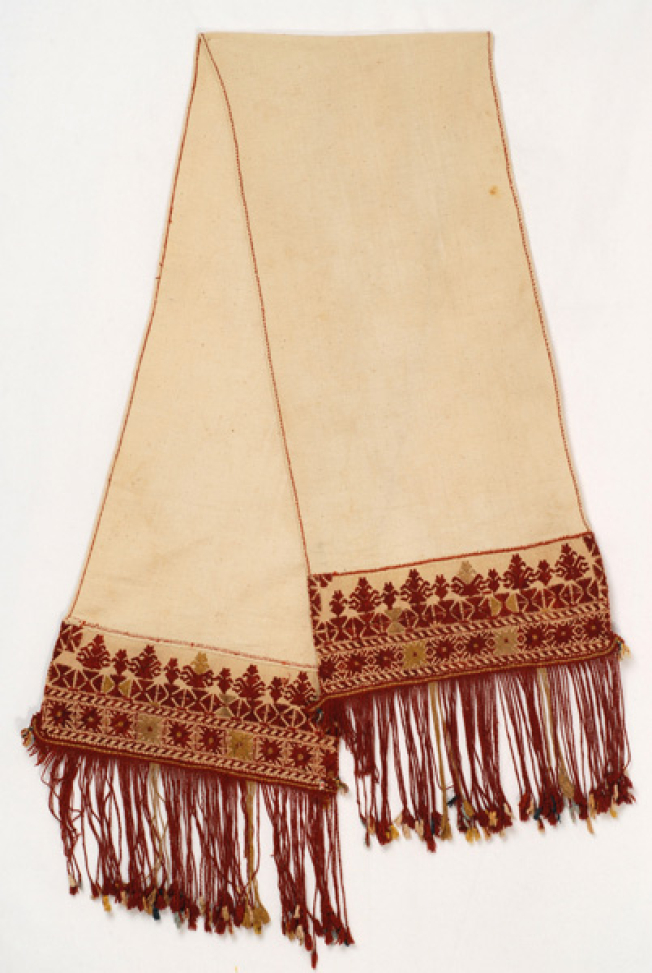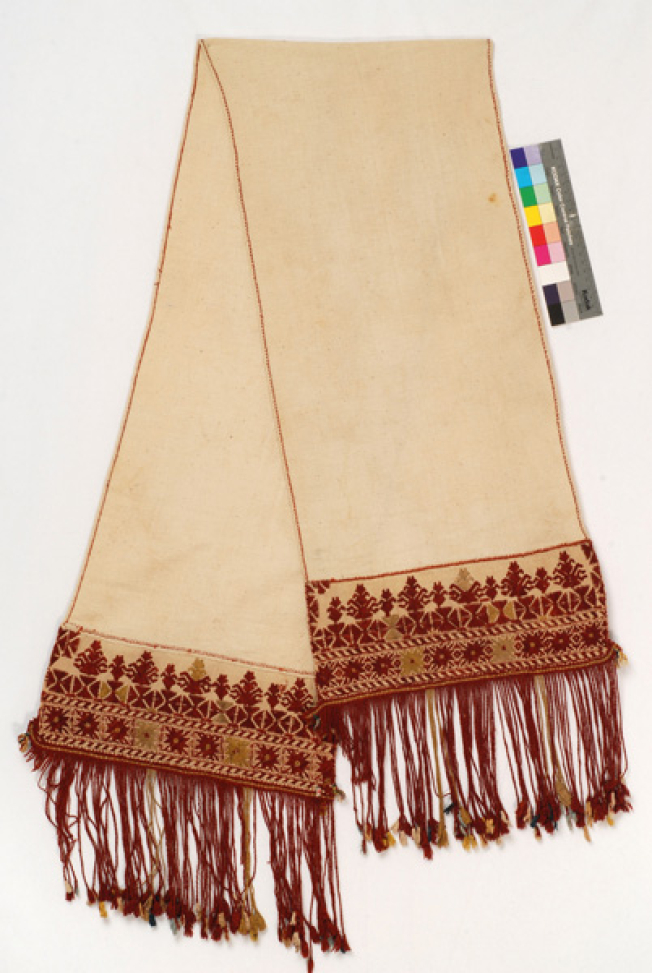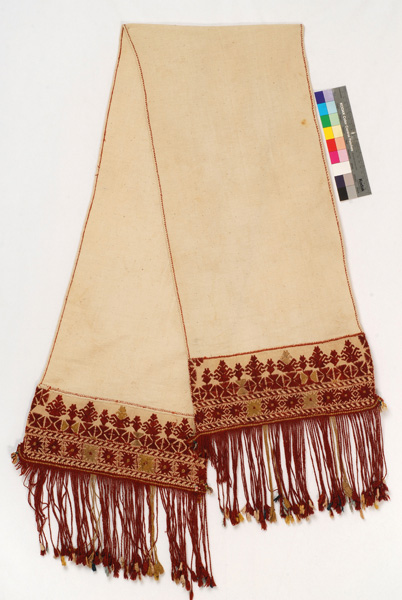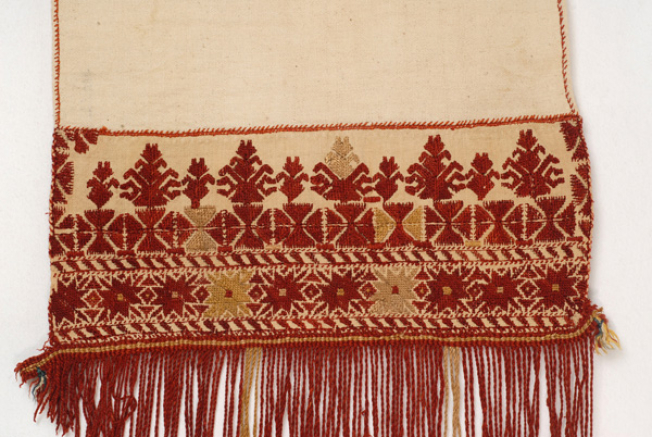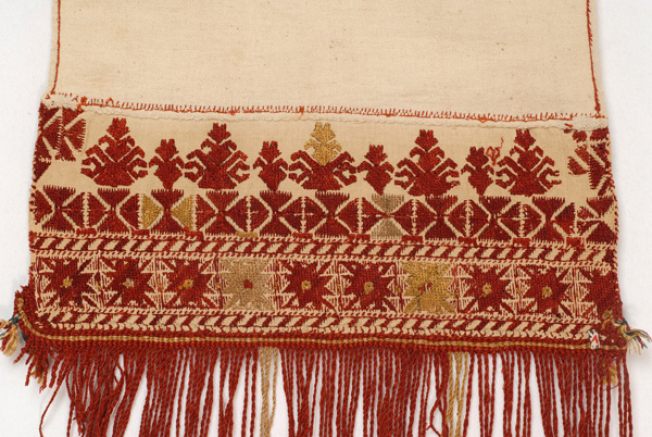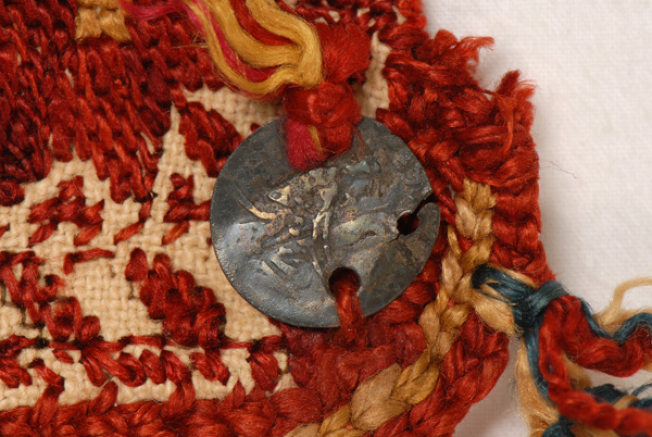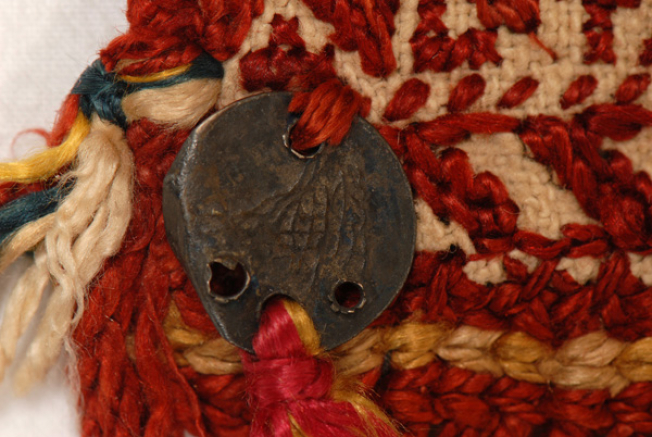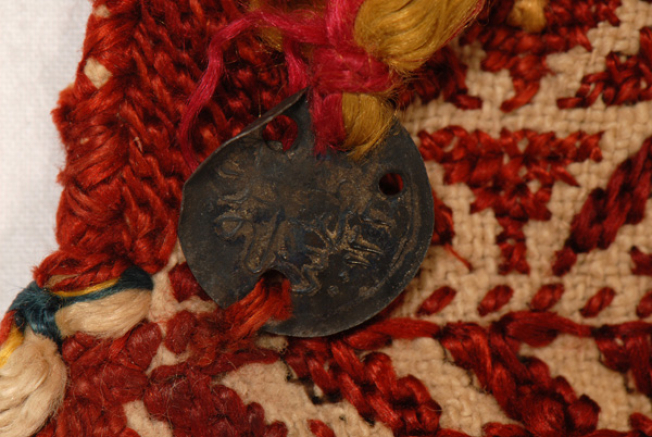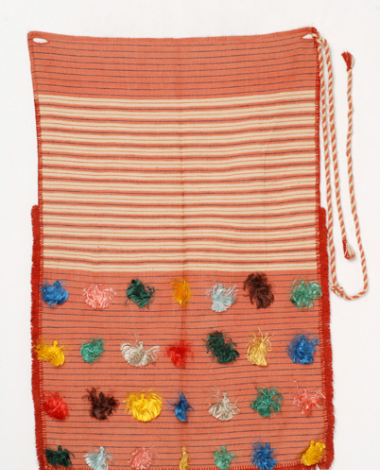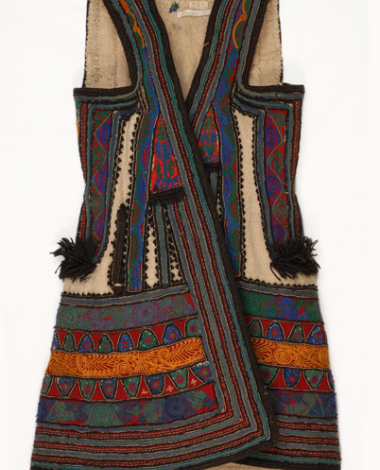head kerchief
900/1,β
Object Identity
Object ID Number
900/1,β
Object name
head kerchief
Other / Local name
Bolia, mesali
Style
costume with sigouni (sleeveless woollen coat)
Production date range
19th century
Part of outfit
Yes
Physical Description
Description
Μπόλια (ή μεσάλι), πιθανόν ο αρχαιότερος τύπος κεφαλόδεσμου στον ελληνικό χώρο. Οι κεντητές άκρες τις μπόλιας (ύψους 12,5εκ.), από αργαλίσιο βαμβακερό πανί, έχουν προστεθεί σε μακρόστενο, υπόλευκο πανί του αργαλειού, πλάτους 32εκ., στριφωμένο στις άκρες με διακοσμητική βελονιά με την ίδια κανελί κλωστή που το ενώνει με τις κεντητές άκρες της μπόλιας. Ένα υπέροχο καφεκόκκινο χρωματίζει το κέντημα που διανθίζεται διακριτικά με χρυσοπράσινες και γκρι-μπεζ κλωστές. Στην χαμηλή ταινία πλαισιώνεται από σειρά με μικρά, πλάγια παραλληλόγραμμα, λάμπουν αστερόσχημα λουλούδια με ανθάκια ανάμεσά τους. Η ψηλότερη ταινία φιλοξενεί σειρά από σταυρούς με τριγωνικές κεραίες. Από πάνω τους εναλλάσσονται μικρό και μεγαλύτερο σχηματοποιημένο μοτίβο: Είναι φυτικό; Είναι ανθρωπομορφικό; Μακριά κρόσια με πολύχρωμα φουντάκια στην απόληξή τους προσθέτουν 17εκ. στο μήκος της μπόλιας.
το δέσιμό τους που είτε προεξέχει, είτε έχει στερεωθεί στην πλαϊνή πλευρά, επιβεβαιώνει την εντύπωση ότι το κέντημα έχει κοπεί. Σταυροί μοιαζει να έκτιζαν το κατακόρυφο περίγραμμα του, και είναι πιθανότατο να έχει κοπεί και η επέκτασή του προς τα επάνω. Στη μία άκρη της μπόλιας, και στις δυο της πλευρές, έχει στερεωθεί από ένα οθωμανικό νόμισμα, που έχει τρυπηθεί για να στολιστεί με φουντάκι από χρυσές και φούξια κλωστές. Αφού τα μαλλιά χτενιστούν ντουρά, οι κοτσίδες στολιστούν με τα κρεμαστάρια και δεθούν σφιχτά τα δυο καφετιά τσεμπέρια (μπαρέζι ή κουγιούτο), πάνω τους τυλίγεται η μπόλια σαν κουλούρα δίνοντας την εντύπωση σαρικιού, ενώ η μια κεντητή της άκρη απλώνει στην πλάτη και η άλλη στολίζει το δεξί μάγουλο. Μαθαίνουμε ότι "τις μπόλιες τους χάριζαν οι γυναίκες στους χτίστες για να τις δένουν στο σταυρό που βάζουν στην κορυφή του σπιτιού σαν τελειώνει. Σαν έφευγαν τις έπαιρναν μαζί τους τυλιγμένες σαν σαρίκι γύρω στο κεφάλι τους."
Decoration & Patterns
Decoration
anthropomorphic decoration (;)
Decorative patterns / subjects
-
Decoration
religious motifs
Decorative patterns / subjects
cross
Decoration
stylized vegetal decoration (?)
Decorative patterns / subjects
-
Decoration
vegetal decoration
Decorative patterns / subjects
-
Width
0.300
Length
1.600
Production
Maker / Designer / Brand
women themselves
Production date range
19th century
Production place (Country | Geographic Area | Prefecture & Region)
Greece |
Peloponnese |
Corinth
Vocha (?)
Material
cotton
metal
soie floche - slightly twisted silk thread
Techniques
counted threadwork,
counted one step vertical stitch
handwoven fabric
Use
User
woman
Status
bride
Occasion
bridal
Date range
19th century
User
woman
Status
married woman
Occasion
festive
Date range
19th century
Place of use (Country | Geographic Area | Prefecture & Region)
Greece |
Peloponnese |
Corinth
-
Acquisition
Acquisition method
Untraced Find
Documentation
Research bibliographic references
Image license
Use the file or the thumbnail of the image according to the license:
CC BY-NC-ND 4.0
Attribution-NonCommercial-NoDerivatives





